Arbeit Macht Frei gate
Entrance to Auschwitz Main Camp
As you exit from the rear of the Visitor's
Center at the Auschwitz Museum, you see the infamous "Arbeit
Macht Frei" gate immediately on your right. The words mean
"Work will set you free." This gate was the main entrance
into Auschwitz I until the camp was expanded in late 1941.
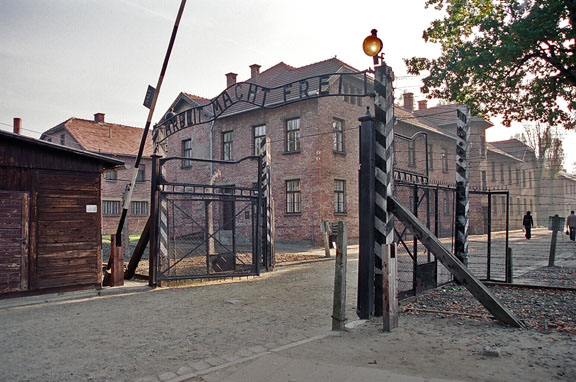
Early morning shot
of the Arbeit Macht Frei gate in main Auschwitz camp, 2005
The photo above shows the Arbeit Macht
Frei gate into the Auschwitz I main camp. It was through this
gate that the prisoners walked each morning on their way to work
in the factories, marching to the beat of music played by the
camp orchestra, stationed in front of the kitchen building near
the gate. Ten hours later, the prisoners marched back through
this gate in the evening, again to the accompaniment of classical
music. Newly arriving prisoners were also greeted by orchestra
music as they passed through this gate after being registered
in the camp. Auschwitz 1 was also a transit camp for prisoners
who were waiting to be transferred to another camp.
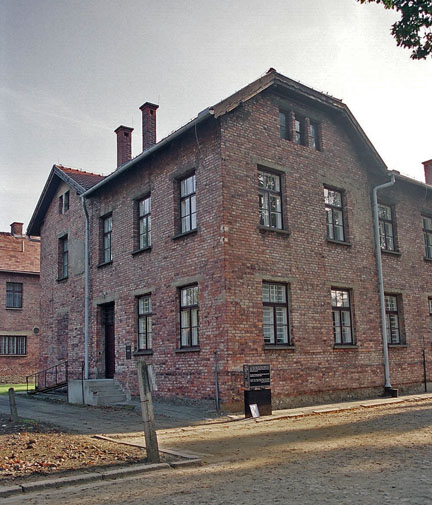 Block 24, the former
brothel, is the first building on the left, 2005
Block 24, the former
brothel, is the first building on the left, 2005
The first building that you see on the
left side, after walking through the gate, is Block 24, which
now houses the Auschwitz archives and the office of the Museum
director. Block 24 was formerly used as a brothel for the Polish
political prisoners; the camp library was on the first floor.
Block 24 also housed the prisoner's art museum, where their artwork
was exhibited. A sign near the corner of Block 24 tells visitors
that the corpses of prisoners, who were executed because they
had attempted to escape, were often displayed here as a warning.
There is no sign which identifies Block 24 as the former camp
brothel and camp library.
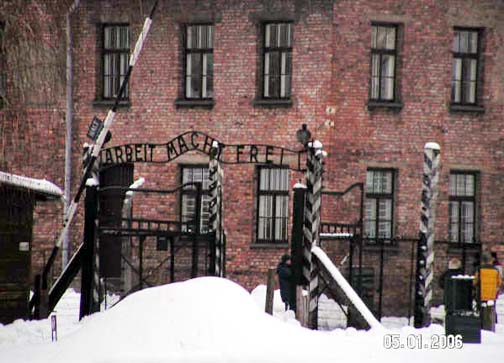 Arbeit Macht Frei gate
with Block 24 in background, January 2006
Photo Credit: José
Ángel López
Arbeit Macht Frei gate
with Block 24 in background, January 2006
Photo Credit: José
Ángel López
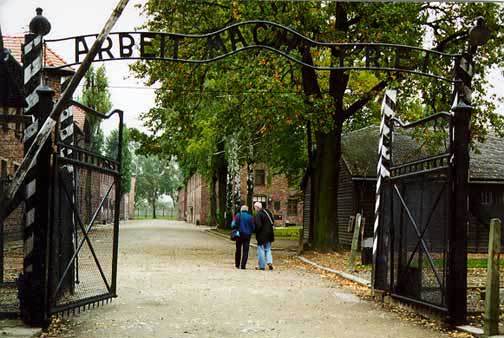
Original gate into
Auschwitz main camp, September 1998
The building on the far right in the
photo above is the camp kitchen; it was painted black when I
visited the camp in 1998, but the original white paint was restored
some time after 2005 when I last visited. The camp orchestra
played where a large tree now stands at the end of the huge kitchen
building.
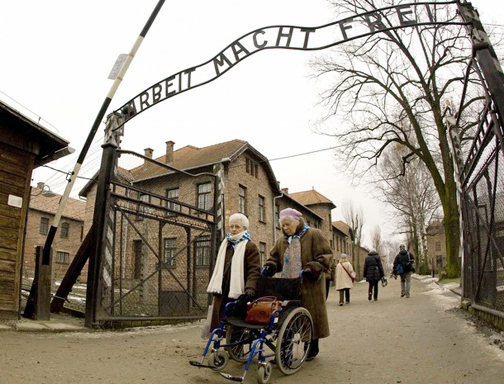 Auschwitz survivors
leave through Arbeit Macht Frei gate, January 2009
Photo Credit: REUTERS
Auschwitz survivors
leave through Arbeit Macht Frei gate, January 2009
Photo Credit: REUTERS
The inmates at the Auschwitz 1 camp were
mainly non-Jewish political prisoners; Jewish prisoners were
sent to the Auschwitz II camp, also known as Birkenau. It was
at Birkeanu that more than a million Jews were killed, mainly
in gas chambers, beginning in February 1942.
In January 1941, the Auschwitz I camp
was designated a Class I camp, where prisoners had a chance to
be released. Only Class I camps had the "Arbeit Macht Frei"
slogan over the gate. Other Class I camps included Dachau, Sachsenhausen,
Flossenbürg and Gross-Rosen. Buchenwald was a Class II camp
and Mauthausen was a Class III camp; neither of these camps had
the "Arbeit Macht Frei" sign. The six death camps (Belzec,
Sobibor, Treblinka, Chelmno, Majdanek and Auschwtiz II, also
known as Birkenau) did not have the words "Arbeit Macht
Frei" on the gate into the camp.
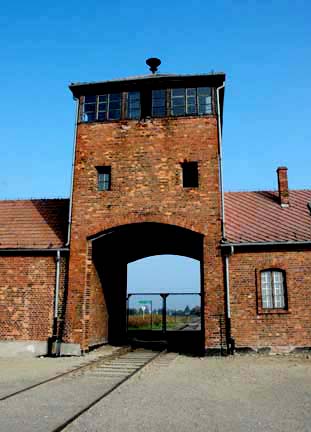 Gate into Auschwitz
II, the death camp, had no sign
Gate into Auschwitz
II, the death camp, had no sign
Commandant Rudolf Hoess, who had served
at both Dachau and Sachsenhausen before becoming the first Commandant
of Auschwitz I in June 1940, ordered the Arbeit Macht Frei sign
to be placed over the original gate into the camp. He wrote in
his autobiography that the words "Arbeit Macht Frei"
mean that works sets one free spiritually, not literally. According
to the Auschwitz Museum, approximately 1,500 prisoners were released
from Auschwitz 1.
This page was last updated on December
19, 2009
|